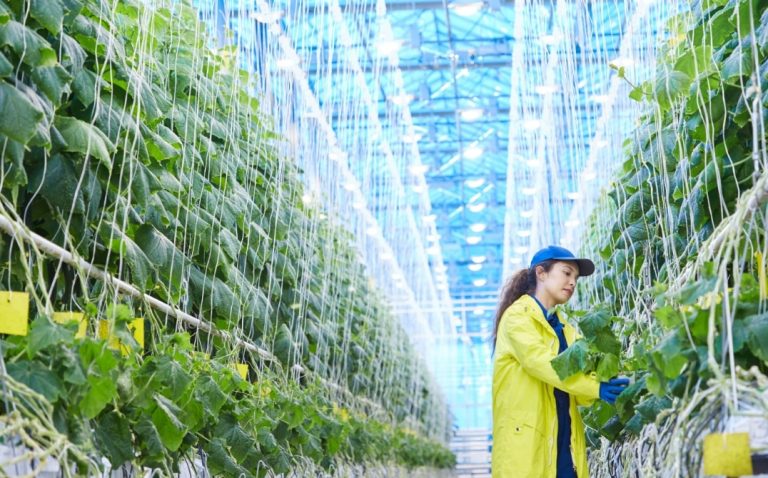Cucumbers are a staple in salads, sandwiches, and fresh snacks, but not all cucumbers are grown the same way. With greenhouse growing becoming more common, many cucumbers on the market are cultivated in controlled environments. But how can you tell if your cucumbers were greenhouse grown?
Here are some easy ways to identify greenhouse grown cucumbers based on their appearance, texture, labels, and seasonality.
1. Shape and Size: Uniformity is Key
One of the easiest ways to identify greenhouse cucumbers is by their consistent size and shape.
Greenhouse Grown Cucumbers:
- Typically longer and straighter, with minimal curvature.
- More uniform in size, making them look nearly identical to each other.
- Slimmer and more elongated compared to traditional field-grown cucumbers.
Tip: If your cucumbers look perfectly straight and evenly sized, they were likely grown in a greenhouse.
2. Skin Texture: Smooth vs. Bumpy
The skin texture of cucumbers can also give clues about how they were grown.
Greenhouse Grown Cucumbers:
- Have a smoother, thinner skin with minimal bumps.
- Typically don’t have a waxy coating since they are grown in a pest-controlled environment.
- Examples include English cucumbers (seedless, wrapped in plastic) and mini cucumbers (crunchy and small but smooth-skinned).
Tip: If your cucumber has bumpy, thick skin or feels waxy, it was likely grown in a field, while a smooth, thin-skinned cucumber suggests greenhouse cultivation.
3. Seed Content: Fewer Seeds in Greenhouse Cucumbers
The number and size of seeds inside a cucumber can also indicate its growing method.
Greenhouse Grown Cucumbers:
- Usually seedless or have very small seeds.
- Less watery, making them ideal for slicing.
- Examples include English cucumbers and cocktail cucumbers, which are almost always greenhouse grown.
Tip: If you slice a cucumber and notice few or no seeds, it was likely grown in a greenhouse.
4. Packaging and Labeling: Key Greenhouse Clues
Checking the label is one of the most reliable ways to determine if a cucumber is greenhouse grown. Look for:
Labels that say “Greenhouse Grown”
- Some brands proudly advertise their greenhouse growing methods.
Hydroponic Labels
- If a cucumber was grown in a hydroponic system (without soil), it was likely produced inside a greenhouse.
Brand-Specific Greenhouse Growers
Many commercial greenhouses produce cucumbers, such as:
- Pure Flavor®
- Nature Fresh Farms
- Mucci Farms
- SUNSET®
- Double Diamond Farms
- Topline Farms
- Red Sun Farms
- Great Lakes Greenhouse Inc.
- Del-Fresco Pure
Tip: If your cucumber comes wrapped in plastic, it’s a greenhouse english cucumber, designed to preserve moisture without using wax.
5. Seasonality: When Did You Buy It?
Since greenhouses allow year-round production, availability can be a clue.
Greenhouse Grown Cucumbers:
- Available year-round, even in winter months.
- Shipped within 24 hours after being picked at their peak.
Tip: If you find fresh, crisp cucumbers in the middle of winter, they were likely grown in a greenhouse.
6. Environmental and Sustainability Considerations
Greenhouse cucumbers are often grown using eco-friendly methods that:
Use Less Water – Hydroponic and greenhouse growing uses up to 90% less water than traditional soil-based farming.
Reduce Pesticide Use – Greenhouse environments control pests naturally, leading to fewer chemicals on the produce.
Lower Carbon Footprint – Many greenhouses are located close to urban areas, reducing transportation emissions.
Tip: If you prefer sustainable, pesticide-free produce, greenhouse grown cucumbers are the better option.
Final Thoughts: How to Identify Greenhouse Grown Cucumbers
If you’re trying to determine if your cucumbers were greenhouse grown, check for:
Long, straight, uniform shape
Smooth, thin skin (often plastic-wrapped)
Fewer or no seeds inside
Year-round availability
Labels that indicate greenhouse, hydroponic growing
Shop greenhouse cucumbers for their crispness, flavor and sustainability! Now that’s something to feel good about!




